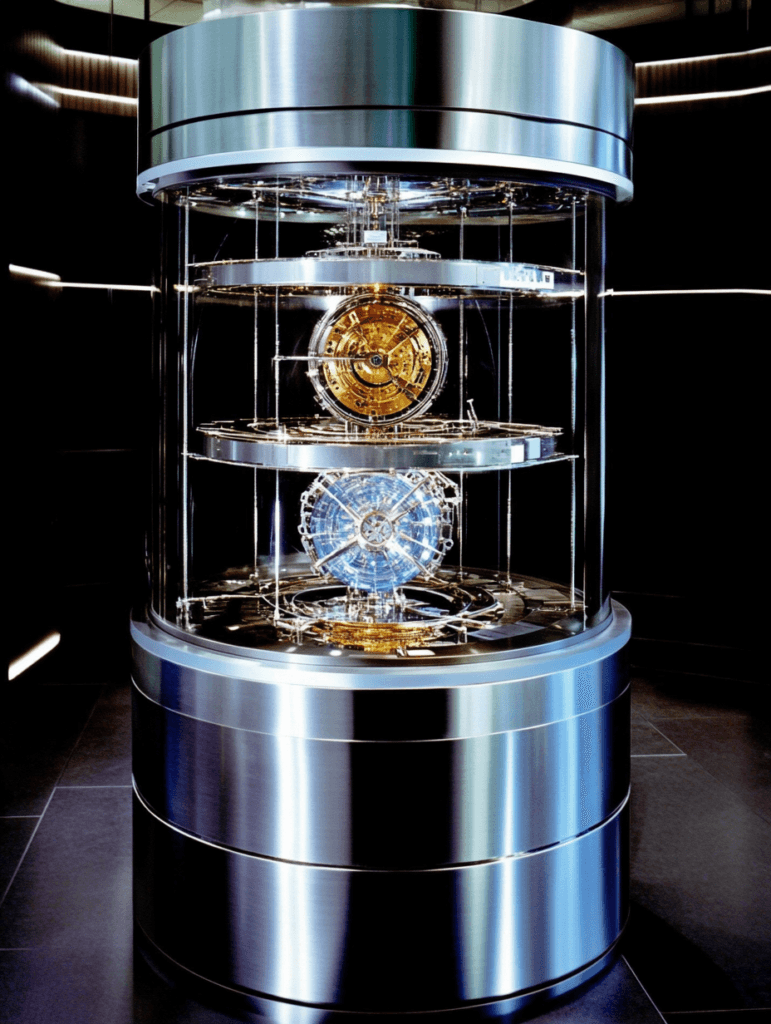Google’s Willow Quantum Computer

In a quiet but monumental unveiling, Google presented Willow, its latest quantum computer, claiming strides that edge us closer to the promise of quantum supremacy. A tool that exists in the realm of probability, beyond the binary ones and zeroes of classical computing, Willow is hailed as a breakthrough—but what does it really signify?
This blog is not merely a news recap. It is a reflection, a critique, and a call to think deeply about what quantum technology represents. Beyond the hype and headlines, let us explore the masterpiece that is quantum computing, the brushstrokes of uncertainty, and the shadow of ambition.
What Makes Willow Different?
Google’s Willow operates within the delicate, enigmatic framework of quantum physics, leveraging qubits to perform calculations that defy classical machines. What sets Willow apart is its focus on error correction—a previously insurmountable challenge.
Which address one of quantum computing’s most significant challenges. Unlike classical systems, quantum computers are highly susceptible to noise and decoherence, where quantum states lose their integrity over time. Willow pioneers a shift toward logical qubits—virtual qubits constructed from multiple physical qubits—that are designed to be more stable and less error-prone. These logical qubits leverage innovative error-correction methods to dynamically detect and mitigate errors as they occur, enabling the system to handle larger and more complex calculations without collapsing under the weight of instability. By focusing on error correction, Google isn’t just scaling up qubits; it’s laying the groundwork for fault-tolerant quantum computing, a crucial step toward making these systems reliable for real-world applications. Willow represents a leap from experimental quantum systems to practical, scalable architectures capable of bridging the gap between theory and transformative computation.
Quantum Possibilities
Quantum computing doesn’t just offer a faster processor—it represents a paradigm shift in how we conceive of computation and problem-solving. Traditional computers operate within the confines of binary logic, with bits toggling between 0 and 1. Quantum computers, however, leverage qubits, which can exist in a superposition of both states simultaneously. This fundamental shift enables quantum machines like Google’s Willow to explore multiple solutions in parallel, unlocking possibilities that are out of reach for classical systems.
At the heart of these possibilities lies the principle of entanglement. When qubits become entangled, their states are interdependent, regardless of physical separation. This unique property allows quantum algorithms to handle complex, interconnected problems with a finesse unattainable by classical methods. Fields like cryptography, optimization, and machine learning stand to be revolutionized as quantum processors uncover solutions to intricate puzzles by operating across vast computational landscapes.
Transforming Industries
Quantum computing promises transformative impacts across industries:
- Drug Discovery and Material Science: Simulating molecular structures at a quantum level could accelerate the discovery of new pharmaceuticals, materials, and chemical processes. For example, Willow could precisely model protein folding—an area where classical computers struggle—unlocking breakthroughs in medicine and materials design.
- Optimization Problems: In logistics, finance, and infrastructure, optimization problems require evaluating countless possibilities to find the best solution. Quantum systems can process these scenarios more efficiently, revolutionizing industries dependent on resource management.
- Artificial Intelligence: Integrating quantum computation with AI could supercharge model training and inference, enabling the development of AI systems that can analyze data faster and more effectively. Quantum algorithms could tackle complex tasks such as pattern recognition or unsupervised learning at an unprecedented scale.
- Climate Modeling: The Earth’s climate is an interconnected system with countless variables. Quantum computing could simulate this complexity with higher precision, offering insights into combating climate change or predicting environmental phenomena.
- Cryptography and Security: Quantum computers could both break and create encryption standards. Current cryptographic protocols would be rendered obsolete by their computational power, necessitating the development of quantum-resistant security systems. At the same time, quantum technologies could enable unhackable communication through quantum key distribution.
A Philosophical Shift in Problem-Solving
What sets Willow apart isn’t just computational capability—it’s a new way of thinking. By embracing the inherent uncertainty and probabilistic nature of quantum mechanics, Willow enables us to tackle questions with no singular answers. This challenges humanity’s classical approach to problem-solving, inviting us to think in terms of probabilities, distributions, and interconnected possibilities.
However, this isn’t just about faster answers. It’s about shifting the narrative: from machines as tools of brute force computation to partners in uncovering the hidden layers of reality. Quantum systems like Willow don’t just provide results—they reshape how we ask questions, blurring the lines between computation, discovery, and philosophy.


Hype vs. Reality
Quantum computing often feels like the rockstar of modern technology, with its promises of revolutionizing industries, solving intractable problems, and delivering results that classical computers could never dream of achieving. However, the reality is far more nuanced. While Google’s Willow represents a significant milestone in the quantum journey, it’s essential to temper the hype with an honest understanding of the technology’s current limitations and future challenges.
The term quantum supremacy, popularized by Google’s earlier experiments, can mislead. It refers to the ability of a quantum computer to solve a problem that classical computers cannot solve in any practical timeframe. While Willow advances this goal with enhanced qubit count and improved error correction, these achievements primarily serve as proof of concept rather than indications of immediate real-world applications.
For instance, Willow’s ability to outperform classical systems in a specific, carefully chosen task doesn’t necessarily translate into practical benefits for industries like healthcare, finance, or logistics—yet. Many of the problems quantum computers aim to solve still require hardware and software advancements that are years, if not decades, away.
Challenges Beyond the Headlines
- Error Correction: Quantum computers are notoriously error-prone due to the delicate nature of qubits. Achieving reliable results requires advanced error correction methods, which currently consume a significant portion of quantum computational resources. While Willow has made strides in this area, practical, fault-tolerant quantum computing remains an aspirational goal.
- Scaling Up: Willow’s 105-qubit processor is a remarkable achievement, but scaling quantum systems to thousands or millions of qubits—necessary for most practical applications—is a monumental challenge. As qubits increase, maintaining coherence and minimizing errors become exponentially harder.
- Algorithm Development: Quantum algorithms are still in their infancy. While theoretical breakthroughs like Shor’s algorithm and Grover’s search algorithm highlight the potential of quantum systems, many industries lack ready-to-use quantum solutions for their problems. Bridging this gap between theory and application will take significant time and effort.
- Energy and Cost: Quantum computers, including Willow, require specialized environments to operate—extremely low temperatures, high-vacuum conditions, and advanced cooling systems. This makes them expensive to build and maintain, limiting accessibility and scalability.
Why It Matters
Despite these limitations, dismissing Willow and quantum computing as mere hype would be shortsighted. The progress made by Google and other pioneers lays the foundation for breakthroughs that, while not immediate, are profound. The advancements in error correction, coherence times, and algorithm design achieved with systems like Willow are incremental steps toward a transformative future.
The challenge lies in balancing the optimism of what quantum computers might achieve with the sober reality of where the technology currently stands. Willow doesn’t solve humanity’s most pressing problems overnight—but it represents a crucial step in the journey. By viewing quantum computing through this dual lens of potential and pragmatism, we can better appreciate its milestones without falling victim to overblown expectations.
The Shadow: Risks and Responsibilities
No masterpiece is without its shadows. Quantum computing poses risks that must not be ignored:
- Encryption Vulnerabilities: Quantum systems could break current cryptographic methods, rendering today’s digital security obsolete. Are we prepared for this disruption?
- Ethical Misuse: As with AI, quantum tools could be weaponized or used to perpetuate inequalities. How do we ensure responsible development?
- Existential Risks: If quantum systems evolve into quantum AI, what safeguards prevent unintended consequences?
The brighter the promise, the darker the potential pitfalls. Balancing these forces requires vigilance, collaboration, and humility.
The Masterpiece: Willow’s Role in the Quantum Renaissance
Willow is not the final product; it is the frame, the palette, and the first brushstroke of a quantum masterpiece yet to be realized. Its true value lies in the questions it provokes and the possibilities it unlocks.
In the quantum dawn, we are no longer merely builders—we are stewards. Willow reminds us that progress is not inevitable; it is a choice, a deliberate act of creation. It challenges us to wield this new power with wisdom, to paint a future that is vibrant, inclusive, and just.
As we stand at the edge of this quantum frontier, let us remember: the masterpiece is not the machine—it is the humanity that shapes it.